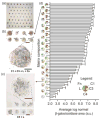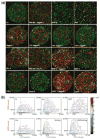High-throughput analysis of signals regulating stem cell fate and function
- PMID: 17656147
- PMCID: PMC2824500
- DOI: 10.1016/j.cbpa.2007.05.036
High-throughput analysis of signals regulating stem cell fate and function
Abstract
Stem cells exhibit promise in numerous areas of regenerative medicine. Their fate and function are governed by a combination of intrinsic determinants and signals from the local microenvironment, or niche. An understanding of the mechanisms underlying both embryonic and adult stem cell functions has been greatly enhanced by the recent development of several high-throughput technologies: microfabricated platforms, including cellular microarrays, to investigate the combinatorial effects of microenvironmental stimuli and large-scale screens utilizing small molecules and short interfering RNAs to identify crucial genetic and signaling elements. Furthermore, the integration of these systems with other versatile platforms, such as microfluidics and lentiviral microarrays, will continue to enable the detailed elucidation of stem cell processes, and thus, greatly contribute to the development of stem cell based therapies.
Figures





Similar articles
-
Microscale technologies for regulating human stem cell differentiation.Exp Biol Med (Maywood). 2014 Sep;239(9):1255-63. doi: 10.1177/1535370214530369. Epub 2014 Apr 15. Exp Biol Med (Maywood). 2014. PMID: 24737735 Free PMC article. Review.
-
Stem cell bioengineering at the interface of systems-based models and high-throughput platforms.Wiley Interdiscip Rev Syst Biol Med. 2012 Nov-Dec;4(6):525-45. doi: 10.1002/wsbm.1189. Epub 2012 Aug 23. Wiley Interdiscip Rev Syst Biol Med. 2012. PMID: 22927218 Review.
-
Emerging strategies for spatiotemporal control of stem cell fate and morphogenesis.Trends Biotechnol. 2013 Feb;31(2):78-84. doi: 10.1016/j.tibtech.2012.11.001. Epub 2012 Dec 5. Trends Biotechnol. 2013. PMID: 23219200 Free PMC article. Review.
-
Engineering approaches toward deconstructing and controlling the stem cell environment.Ann Biomed Eng. 2012 Jun;40(6):1301-15. doi: 10.1007/s10439-011-0452-9. Epub 2011 Nov 19. Ann Biomed Eng. 2012. PMID: 22101755 Free PMC article. Review.
-
Extracellular matrix microarrays to study inductive signaling for endoderm specification.Acta Biomater. 2016 Apr 1;34:30-40. doi: 10.1016/j.actbio.2016.02.014. Epub 2016 Feb 12. Acta Biomater. 2016. PMID: 26883775 Free PMC article.
Cited by
-
Identification, proliferation, and differentiation of adult Leydig stem cells.Endocrinology. 2012 Oct;153(10):5002-10. doi: 10.1210/en.2012-1417. Epub 2012 Aug 3. Endocrinology. 2012. PMID: 22865373 Free PMC article.
-
Designing materials to direct stem-cell fate.Nature. 2009 Nov 26;462(7272):433-41. doi: 10.1038/nature08602. Nature. 2009. PMID: 19940913 Free PMC article. Review.
-
High-throughput identification of factors promoting neuronal differentiation of human neural progenitor cells in microscale 3D cell culture.Biotechnol Bioeng. 2019 Jan;116(1):168-180. doi: 10.1002/bit.26839. Epub 2018 Oct 27. Biotechnol Bioeng. 2019. PMID: 30229860 Free PMC article.
-
Deciphering the combinatorial roles of geometric, mechanical, and adhesion cues in regulation of cell spreading.PLoS One. 2013 Nov 25;8(11):e81113. doi: 10.1371/journal.pone.0081113. eCollection 2013. PLoS One. 2013. PMID: 24282570 Free PMC article.
-
Efficient dielectrophoretic patterning of embryonic stem cells in energy landscapes defined by hydrogel geometries.Ann Biomed Eng. 2010 Dec;38(12):3777-88. doi: 10.1007/s10439-010-0108-1. Epub 2010 Jul 8. Ann Biomed Eng. 2010. PMID: 20614250 Free PMC article.
References
-
- Boyer LA, Mathur D, Jaenisch R. Molecular control of pluripotency. Curr Opin Genet Dev. 2006;16:455–462. - PubMed
-
- Van Hoof D, Passier R, Ward-Van Oostwaard D, Pinkse MW, Heck AJ, Mummery CL, Krijgsveld J. A quest for human and mouse embryonic stem cell-specific proteins. Mol Cell Proteomics. 2006;5:1261–1273. - PubMed
-
- Eckfeldt CE, Mendenhall EM, Verfaillie CM. The molecular repertoire of the ‘almighty’ stem cell. Nat Rev Mol Cell Biol. 2005;6:726–737. - PubMed
-
-
Scadden DT. The stem-cell niche as an entity of action. Nature. 2006;441:1075–1079.. Insightful review of recent advances identifying stem cell niches in multiple organ systems. Important components of stem cell niches are highlighted including paracrine signals, extracellular matrix composition, as well as metabolic elements such as reactive oxygen species and calcium concentrations. The dynamic nature of stem cell microenvironments and the potential for targeting normal or cancer stem cell niches for therapeutic purposes is also discussed.
-
-
- Fuchs E, Tumbar T, Guasch G. Socializing with the neighbors: stem cells and their niche. Cell. 2004;116:769–778. - PubMed
Publication types
MeSH terms
Grants and funding
LinkOut - more resources
Full Text Sources
Other Literature Sources
Medical

